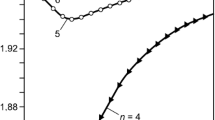Summary
In HPLC calibration the expressions lowest calibration limit and determination limit are defined in statistical terms. The lowest calibration limit is the minimum mass in the measured series of calibration points. It is calculated from the confidence interval of the inverse of the calibration function as the lowest mass limit that may be differentiated from zero mass with a preset probability of error. If the calculated lowest calibration limit is lower than the actual data, points at lower concentration may be measured. The determination limit is the smallest concentration of an analysis that is differentiated from the concentration zero or an apparent blind value in the calibration curve with a given probability of error.
Using two different UV-detectors (variable wavelength and photodiode-array) the lowest calibration limit is experimentally evaluated and compared with specific data for the detectors.
Similar content being viewed by others
References
H. Kaiser, Spectrochim. Acta3, 40 (1947).
L. A. Currie, Anal. Chem.40, 586–593 (1968).
A. Hubaux, G. Vos, Anal. Chem.42, 849–855 (1970).
IUPAC, Spectrochim. Acta33B, 242 (1978).
ACS Subcommittee Environmental Analytical Chemistry, Anal. Chem.52, 2242 (1960).
V. Dammann, W. Funk, G. Oehlmann, C. Vonderheid, Vom Wasser58, 207 (1982).
W. Funk, V. Dammann, C. Vonderheid, G. Oehlmann, Statistische Methoden in der Wasserchemie; VCH Verlagsges. Weinheim 1985.
S. Ebel, U. Kamm, Fresenius Z. Anal. Chem.316, 382–385 (1983).
S. Ebel in S. Ebel, W. Dorner (Edit.), parat Jahrbuch Chemielabor 1987 (S. 107–118).
S. Ebel, U. Becht, Fresenius Z. Anal. Chem. (im Druck).
H. M. N. Irving, H. Freiser, T. S. West, Compendium of Analytical Nomenclature (Definite IUPAC Rules 1977); Pergamon Press Oxford 1977.
N. L. Draper, H. Smith, Applied Regression Analysis: Wiley & Sons, New York, 1981.
S. Ebel, Comput. Anwend. Lab.1, 55–61 (1983).
P. A. John, W. J. McCarthy, J. D. Winefordner, Anal. Chem.39, 1495–97 (1967).
J. P. Foley, Chromatographia18, 50 (1984).
J. E. Knoil, J. Chrom. Sci.23, 422 (1985).
S. Ebel inH. Engelhardt, K. P. Hupe (Edit.), Kopplungsverfahren in der HPLC, GIT Verlag Darmstadt 1985 (S. 28).
A. F. Fett, B. J. Clark, H. P. Scott, J. Chromatogr.,316, 423 (1984).
Author information
Authors and Affiliations
Additional information
Dedicated to Prof. Dr. E. Bayer, Tübingen on ocassion of his 60th birthday.
Rights and permissions
About this article
Cite this article
Ebel, S., Kühnert, H. & Mück, W. Limits of determination and calibration in HPLC. Chromatographia 23, 934–938 (1987). https://doi.org/10.1007/BF02261474
Received:
Accepted:
Issue Date:
DOI: https://doi.org/10.1007/BF02261474




